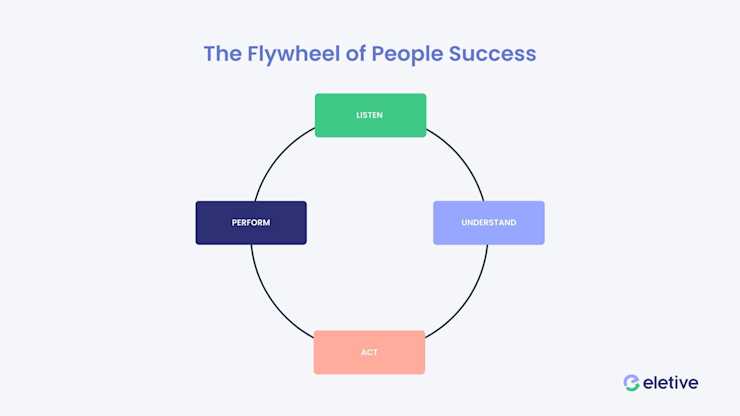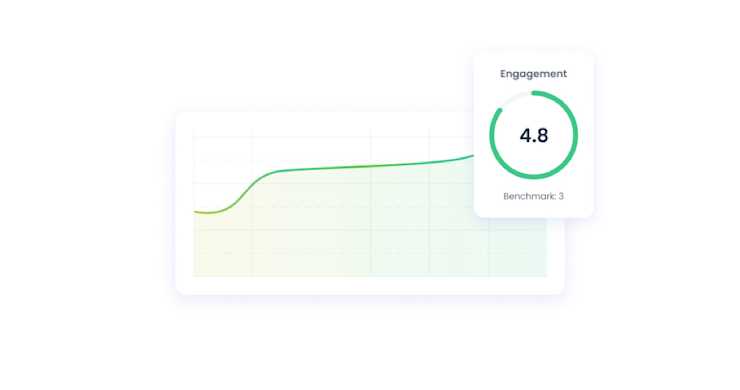Agile HR is an approach to Human Resources grounded in the principles of agile development. It seeks to make the business processes and HR services of a company more dynamic and reactive to market changes.
The main purpose of adopting an agile human resources strategy is to make companies more adaptive and flexible in today's high-paced and ever-changing business environment. The goal is to increase responsiveness, collaboration, and innovation to better respond to customer demands, react to market trends, and succeed in the long run.
In this article, we'll explore what Agile HR is, and the tools and processes required to successfully implement an Agile HR approach.
The Agile approach – a brief background
The Agile HR approach originally stems from Agile Development, a method of software development that emphasises iterative and incremental delivery, flexibility, and cross-functional collaboration. It originated in the late 1990s as an alternative to traditional, hierarchical approaches to software development, which were often criticised for being too slow and inflexible.
Agile Development is based on the Agile Manifesto, a set of principles for software development that prioritise customer satisfaction, collaboration, and adaptability over strict planning. Over the years, the Agile approach has proven to bring results, and it's increasingly gaining ground in various industries for project management, product development, and more recently, HR.
From service providers to strategic partners
Successful implementation of Agile HR requires a shift in mindset. From the traditional approach of human capital management to an agile mindset and approach that emphasises flexibility, quick action, and collaboration. It requires a shift from the traditional view of “HR as a service provider” to a view of “HR as a strategic partner”.
Agile teams in HR should not only think about how they can provide value-driven services, but also how they can help drive innovation and build better customer relationships. This type of thinking helps companies better align their people strategy with their product strategy, and, ultimately, with their customer demands.
The principles of Agile HR
Agile HR focuses a lot on employee development. By providing employees with the necessary resources and support, organisations can create an environment that encourages growth and development. This, in turn, can help create a more engaged and productive workforce, improved customer service, and increased profitability.
At its core, Agile HR seeks to provide “agile” and “flexible” responses to customer demands, while maintaining a high-touch relationship with employees. It's both a continuous process of improvement and an organisational culture, guided by the following key principles:
People over processes:
Agile HR puts the needs of the internal customers (the employees) over processes and procedures.
Flexibility and adaptability:
Agile HR is flexible and adaptable to the business environment, the changing employee needs, and technological advances.
Collaboration instead of silos:
Agile HR emphasises teamwork and collaboration between HR and other departments to achieve common goals.
Employee empowerment:
Agile HR empowers employees to take ownership of their development, career paths, and overall job satisfaction.
Continuous improvement:
Based on continuous feedback, Agile HR constantly iterates to improve processes, enhance the employee experience, and drive business results.
Data-driven decision-making:
Agile HR leverages data and analytics to inform decision-making.
Related reading:How intelligent employee surveys can improve your people decisions

Agile HR and the Flywheel of People Success
At Eletive, we talk a lot about something we call the Flywheel of People Success. It represents a modern and agile approach to HR, and culture, that we consider to be the key to building highly engaged teams and organisations. In fact, we've built our whole product and platform around this concept.
The Flywheel of People Success, which could also be called the employee feedback loop, is a continuous process consisting of 4 steps:
Listening to the people of the organisation
Understanding the feedback
Taking action on the results
Performing better – together
Eletive is a People Success Platform for modern HR, that allows for a truly agile way of approaching people strategy and performance. By connecting all the dots, we provide a complete toolkit for building efficient and Agile HR operations and a feedback-driven culture where people thrive.
Recommended reading: Increase employee engagement with the Flywheel of People Success
Agile HR: Tools and processes
While agile ways of working start with mindset, there are also practical aspects to take into consideration, for a successful implementation. Let's have a closer look at some of the tools and processes involved in Agile HR, and how we at Eletive can help you implement an agile approach.

Important tools for Agile HR
Real-time pulse surveys
Agile HR requires a well-functioning feedback loop within the organisation. The best way to achieve that is by implementing automated realtime pulse surveys, to continuously monitor the employee experience. Traditionally, many HR teams have only sent out surveys on a yearly basis, but that does not provide the insights needed to be truly agile and flexible. More frequent employee surveys provide realtime insights.
Employee engagement analytics
Employee surveys allow HR teams to listen to the people in the organisation and collect valuable feedback. But in order to make data-driven decisions, which is key in Agile HR, you also need tools for understanding and analysing the survey results. Depending on the size of your organisation, these needs differ a bit, but it's always essential to be able to understand and visualise the results, and track how they evolve over time. This allows you to evaluate the effect of HR initiatives, and to quickly spot trends and correlations. With Eletive, you have access to real-time heatmaps and reports that visualise the results in an intuitive way.
Action plans
Once you've gathered feedback and analysed the employee survey results, the next step is to take action where it's needed. For this, Eletive offers easy-to-use action plans that can be connected to the different drivers of employee engagement. These can be used both on an individual, team and organisational level, and help organisations align and get things done.
OKRs (Objectives and Key Results)
OKRs is a goalsetting and goal-tracking method that works well with an agile approach. It helps both the HR team and the organisation identify the strategic long-term goals, as well as the actions that will help you get there. In the Eletive platform, it's easy and intuitive to track Objectives and Key Results at Every level of the organisation.
1:1s - One-to-One meetings
One-to-one meetings are important when implementing and maintaining an agile approach to HR. The feedback that surface in 1:1 meetings is deeper than in employee surveys. The meetings also provide an important opportunity for managers to give their team members feedback and guidance. In the Eletive platform, organisations can provide customised one-to-one meeting templates, to support and empower the managers in their work. Scheduling and meeting notes are also included in the platform, to help make the most of these important meetings.
360 feedback surveys
360-degree feedback, or multi-rater feedback, is an important tool in agile performance management. By incorporating feedback from not only the manager, but also from peers and direct reports, it provides the survey subjects with valuable insights into how they're behaviour and performance is perceived by others. 360 feedback is a great tool for employee development, which is a main focus in Agile HR.
Important processes in Agile HR
Increasing self-leadership in the organisation
A key aspect of Agile HR is to improve accountability and self-leadership in the organisation. Everyone is expected to take responsibility for their goals and employee experience. In the Eletive platform, both employees and managers are provided the tools for owning their employee journey and taking action when something is not working. In the platform, every individual has access to their own dashboard, where they can follow their survey results, and receive science-based advice and suggested actions. The advice and actions are based on OBM (Organisational Behaviour Theory) and are designed to encourage self-leadership and self-reflection.
Empowering managers and employees to take action
In Agile HR, the idea is to empower the managers and employees to help cocreate the employee experience. Traditionally, much of the responsibility for increasing employee engagement would lie with HR. But in Agile HR, as well as in the Eletive platform, this dynamic has changed. The responsibility of driving employee engagement and continuously improving the workplace is shared by everyone in the organisation.

Staying ahead in a competitive market
Agile HR is closely connected to talent management and performance management. One of the main goals is to ensure the organisation has access to to the skills and resources necessary to remain competitive in the market.
Agile HR is about creating an environment where employees are encouraged to take risks and experiment with new ideas. This allows the organisation to stay ahead of the competition and remain innovative. To achieve this, agile HR teams focus on building a culture of trust and collaboration, where team members are encouraged to work together to solve problems and create solutions.
Benefits of Agile HR
There are many benefits of agile HR. Focusing heavily on employee empowerment and learning and development, many companies that take an agile HR approach can expect increases in customer satisfaction, productivity, employee engagement, and, ultimately - profits.
Implementing an agile HR strategy can help build a better working environment, where employees feel more engaged and involved in the company’s decision-making process. Agile HR can also help companies become more efficient. Streamlining processes and eliminating unnecessary bureaucracy can save time and money, while HR is still able to provide employees with the support they need. In other words, Agile HR can lead to improved job satisfaction as well as increased productivity and profitability.
Building an Agile HR function
Some core components of an agile HR system include: creating cross-functional teams with different expertise; transparent communication within teams; using customer data to inform decisions; developing trust between teams; constantly seeking feedback; and building on the successes of recent experiments.
It's important to ensure that agile principles are embedded into the company culture. This can be done by encouraging employees to take ownership of their work, providing them with the necessary resources to succeed, and rewarding them for their efforts. By doing so, the organisation can create an environment where employees are empowered to take initiative and innovate, leading to improved customer satisfaction and increased productivity.
Agile HR and employee engagement
Adopting an agile HR strategy can have a huge impact on employee engagement in the workplace. Through their focus on employee empowerment, agile HR practices encourage employees to take initiative, experiment, and come up with innovative solutions. This creates an environment where employees feel they are true contributors to the company’s success, which leads to greater engagement. Agile HR helps create a link between employees’ efforts and the company’s ultimate goals – something that is often lacking in traditional HR initiatives.
Agile HR helps foster a positive culture, where employees take ownership of their work and make decisions. It encourages people to work together to reach goals and helps create a sense of camaraderie and team spirit. This, in turn, often leads to higher levels of engagement. Agile HR practices also help reduce bureaucracy and streamline processes, making it easier for employees to get their work done and feel more productive.
Challenges of implementing Agile HR
Implementing an agile HR strategy isn't without challenges. One common challenge is convincing senior leaders that there is enough value within the process to warrant the transition from traditional methods. To overcome this, your HR department may need to showcase the potential gains you see with the adoption of an agile way of working. When building the business case for Agile HR, it makes sense to take things like increased customer satisfaction and improved employee engagement into your calculations.
It's important for companies implementing an agile system to ensure that all relevant stakeholders are well-informed about the new processes before making any changes. Without sufficient training for employees and senior leaders, there may be a mismatch between what is expected from them in this new environment. This, in turn, can lead to friction and frustration.
Making the case for Agile HR
To truly reap the benefits of an agile HR system, it's essential to make sure all stakeholders - from individual employees and the HR team to senior leadership - understand why this new way of working is important for the organisation's success. By providing a clear case for why agile HR is beneficial for customers, employees, and the business as a whole, HR professionals can ensure everyone is on board and fully committed to making it succeed. Get in touch with our expert to learn more about how Eletive supports Agile HR!

























